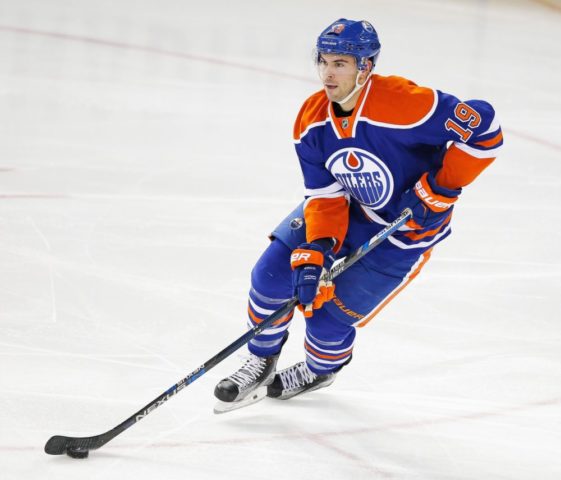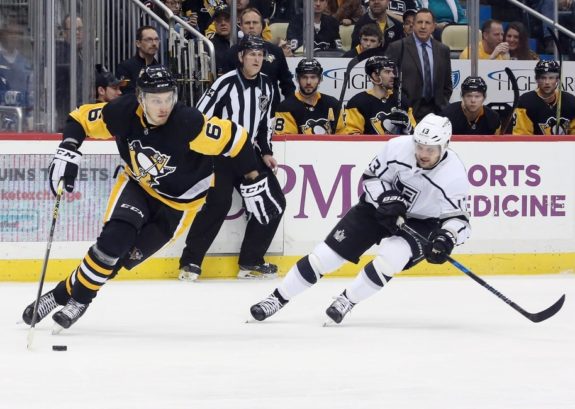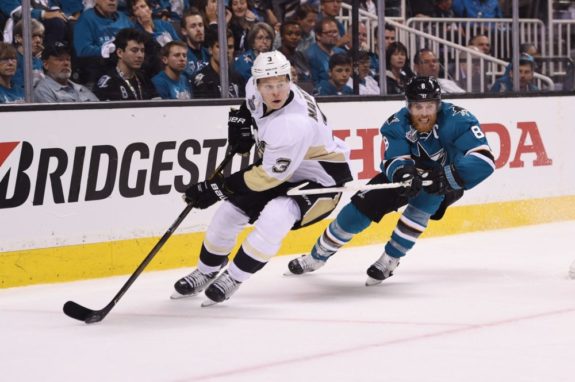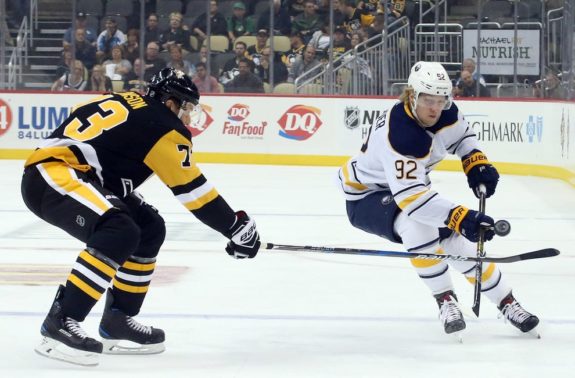The Pittsburgh Penguins are excellent at rehabilitating defensemen. But it’s also rare to see them praised for their defense: especially coming off a 7-6 overtime win against the Washington Capitals, an opener that felt like an early 90’s time warp.
Even Sidney Crosby couldn’t contain his excitement when he referred to “old time hockey” in a post-game interview. There is something fundamentally risky about the Penguins’ style of play, going back to the Lemieux era. The team has had Hall of Fame defensemen patrol the blue line over the decades, but a safe defensive game has never been the hallmark of their play. Perhaps now more than ever, the effect of such an aggressive offensive strategy is visible. When it works, it facilitates the skilled forwards, and when it fails, it causes glaring turnovers and unnecessary goals against.
Embracing Risky Hockey
No defenseman embodies the Penguins more than Kris Letang. His benefits and drawbacks have been discussed in great length by The Hockey Writers’ Connor Mactague and by many others elsewhere. He’s been unpopular for months at a time and a timely hero on the biggest stages. When healthy, he is exactly what the Penguins aspire to be on the back-end as a unit: aggressive and oblivious to risk.
He also characterizes the hazards of a reckless defender with his regular turnovers. It’s unlikely he’ll ever win a Norris Trophy, but he drives possession and creates high percentage scoring opportunities regularly. Turnovers are expected but they are (usually) negated by his swift skating and athleticism.

The Penguins’ philosophy has been carefully crafted by head coach Mike Sullivan and assistant coach Jacques Martin. It empowers the team’s dynamic talents to attempt creative plays. The organization wants its defenders to use their speed to skate past trouble and their athleticism to win one-on-one puck battles.
Every individual on defense is exceptionally skilled but the team seems to encourage flip dumps, cross-ice passes through multiple players and other risky maneuvers, in the hopes that the chances for will outweigh the chances against. Martin specifically has forged a defensive system that can get forwards the puck in transition, while attempting to limit high-quality chances against through pure athleticism.
The Success Stories: Schultz, Cole & Oleksiak
Justin Schultz is at the top of the list of successful reclamation projects. His painful fiasco with the Edmonton Oilers has largely been forgotten – rightfully so in the wake of two lengthy Cup runs. However, it can’t be overstated how bad he was for the Oilers. He would miss assignments multiple times on the same shift, turn the puck over directly in front of his goaltender, and attempt stretch passes that were nowhere near anyone.
After being a highly sought-after free agent, he could have fallen out of the league had it not been for Jim Rutherford’s keen eye for cheap talent. The turnaround was near immediate. It befuddled Edmontonians but he became a top-four defender, a positive possession player, and racked up helpers. What changed?

Schultz was overthinking every pass, every shot, every transition and became tentative as a result. The Penguins simply told him to get out of his own head. Of course, there were subtle adjustments to gap control, shot blocking strategy, and the introduction of situational zone exits, but the coaching staff knew that Schultz was skilled and fleet-footed enough to take control of his own game. He proved them correct, going on to record 51 points in 71 games in 2016-17 with a plus-27 rating.
Ian Cole joined the team at the tail-end of the 2014-15 season when his career was similarly on the outs. Despite being a former first-round selection, he was often scratched by the St. Louis Blues and was traded for the Penguins’ 7th defenseman at the time, Robert Bortuzzo, in a move that many considered insignificant at the time.
For the Blues, Cole looked sluggish and was often hemmed in his zone. However, he immediately adapted to Pittsburgh’s system, despite not being a speed demon. Like Schultz, however, he had a decent passing ability, hockey IQ, and was in exceptional physical shape. The difference in the quality of competition he faced and excelled against is remarkable.

Cole was indispensable in many late-game situations when a lead needed to be preserved or a penalty killed off. He became more cerebral with the Pens, so much so that his loss was felt this past post-season. What caused this drastic shift in Cole’s play? Martin’s defensive scheme rewarded creativity and didn’t disproportionately punish risk. Without fear of being scratched for a turnover, Cole was allowed to find his comfort zone.
Jamie Oleksiak is a recent addition but this pickup by Rutherford was genius. Oleksiak was also drafted early, 14th overall in 2011, and is a physical anomaly. His 6-foot-7 frame moves along the ice in surprisingly fluid strokes. He passes with authority and he joins rushes and recedes back into position with ease. He can often be found in the high slot or even in the opposing corner trying to create some sort of opportunity before striding over to his point. He fit seamlessly into the Penguins’ creative passing game and his imposing stature has been welcome.

Why did Oleksiak thrive in Pittsburgh but struggled with the Dallas Stars, also an offense-heavy organization? Martin’s system rewards solid pinches with increased ice time, two-line passes were encouraged, and Sullivan had his wingers nearly always back-checking with speed, covering for ill-timed defensive decisions. The system is designed to inspire confidence in its defenders by allowing them to consistently contribute to a 5-man offensive unit.
Failures & Underperformers: Hainsey, Hunwick & Maatta
The most striking example of a player who didn’t fit with the Penguins is Ron Hainsey. Many observers let Hainsey’s lackluster play at the tail end of the 2016-17 season slide, as he was adjusting to a new system after a pre-deadline acquisition from the Carolina Hurricanes. However, his play in the playoffs that Cup-winning season was awful.
The overall defensive play in 2017 was a big reason the defending champs nearly lost in Game 7 to a middling Ottawa Senators team. Hainsey has never recovered since being traded from Carolina; though logging huge minutes for the Toronto Maple Leafs, his possession stats have remained relatively poor. Through one round last post-season, his Corsi adjusted relative was -24.2%. Essentially, adjusted for his quality of competition, he could be counted on to produce one chance for every three chances against. That’s unspeakably bad.

Ironically, Hainsey was sought after by Rutherford for the exact same reasons that he failed so spectacularly. Generally, Hainsey was a risk-averse player who could be counted on to make the “simple” play, jamming a clear up the boards or retreating to the front of his net rather than chase attackers. Unfortunately, he struggled to keep pace with the rest of the Penguins. His age showed often, and he was out-muscled and out-sped frequently in April, May, and June. Hainsey wasn’t fast enough or creative enough offensively to contribute to the Penguins’ scheme.
Matt Hunwick is a similar story. He’s another veteran defenseman who had decent enough passing skills but never found his way in the Steel City. Last season, was his only outing before his salary was dumped with the Buffalo Sabres along with Conor Sheary. Unlike Hainsey, Hunwick could skate at a decent pace. His failure was more indicative of poor decision making and a lack of comfort in such a high-flying, high-risk system.
However, throughout his career, he has struggled to stay in weak lineups and has been scratched often. He was a 7th round pick and at age 32, he didn’t fit the mold of a prototypical Penguins defenseman. His addition was questionable at the time and thankfully was corrected this offseason.

More controversially, but perhaps most telling of all, is Olli Maatta. Maatta is a strange addition to this list of has-beens, but hear me out. He entered the league at the ripe age of 19, forcing himself onto the roster with his other-worldly hockey IQ and sublime skills. He finished 5th in Calder voting, was praised by teammates in an injury-laden season, and looked destined for stardom. He posted 29 points in 78 games in his rookie season, but even more impressive was his stalwart play in his own zone.
He anticipated top-tier players with perfect gap control and wonderfully precise stick checking. He was undersized, to be sure, but he never looked out of place. Maatta then went on to miss large portions of the next three seasons, due to illness (thyroid cancer) and injury. Last season was the first healthy season in which he played all 82 games, but he had an up-and-down year. At times he looked like the Penguins’ most stable defender, while at others he looked lost.

Maatta’s most glaring problem isn’t his skill or savvy; he may be one of the most cunning players on the club. The issue is his overall physical ability and, particularly, his speed. He is slow, small in frame, and cannot be counted on to defend attackers with any sort of momentum. The amount of odd-man rushes allowed by Maatta has drastically increased since his rookie season.
Most of that is due to the system Martin formally introduced in 2015-16. Although Martin was on the bench in Maatta’s rookie season, his influence was limited under Dan Bylsma’s final season as head coach. Aggression from the back-end is paramount under Martin which requires the ability to skate with speed in order to negate rush opportunities in the opposite direction.
Additionally, Maatta never fully tapped into his offensive upside largely because he isn’t fast enough to join the attack in transition. Much of the Penguins’ offense comes off the rush, for better or worse. When you’re two to three strides off the pace, it’s difficult to consistently find the puck. Unless he drastically improves his skating ability and physicality, he is destined to underperform for the Penguins, regardless of his pedigree and intelligence.
The Prediction: J. Johnson
Past experience might help us predict the future. Defenders who have found success in Pittsburgh are those who can be introduced in a protected role and transition to an increasingly potent opposition. They are generally physically blessed, quick to accelerate, aggressive, drafted early, and show good offensive instincts, especially in transition; a good description of Jack Johnson.
For all his faults, he epitomizes the traits valued by the Pittsburgh model. And perhaps most intriguingly, he has the ability to lay intense body checks and clear the crease, something the team has lacked for many years. Johnson was maligned by the Los Angeles Kings for a consistently poor plus/minus and was benched by head coach John Tortorella when he was with the Columbus Blue Jackets, presumably for his downturn in overall production; although that rationale was contested this offseason when ESPN covered the profanity-laced fallout.
However, when Johnson is used in a primarily defensive role, he excels due to his physical abilities. His best statistical season, 2016-17, was the only one of his career with under 40% offensive zone starts. Keep him around 35% and he should excel. Watching Johnson play for team U.S.A. in international competition, you can see there is a brutish effectiveness to his game when he is deployed properly.

As to Johnson’s pedigree? He was drafted 3rd overall in 2005, two spots behind Crosby. Similar to Oleksiak, Schultz, and Cole, he may start to tap into his potential if Martin’s system is really as pressure-free as it seems, and Johnson should finally have a home in the NHL at the age of 31.
Many questioned the signing on July 1, and it was difficult to combat skepticism in light of his poor advanced stats. Mark Madden of the Tribune-Review was one of the only columnists that defended the move in the Pittsburgh media. Although Johnson’s physical ability may decline over the course of a confusingly long five-year deal, expect Johnson to be a net positive for his first two or three seasons. Early results are mixed, but I still believe he will become a useful addition.

Ultimately, the Penguins have work to do on defense. They’ve conceded 11 goals in the first 2 games and left Murray on his own against multiple odd-man rushes. That said, it seems to me that the team will make only minor tweaks to their strategy, which will likely revolve around zone coverage, pairing adjustments, and improved communication between defenders and back-checkers. The defense will always be swift and press the attack. They will always take risks, sometimes to the groans and gasps of the fanbase. The past three seasons have shown us that the scheme has been relatively effective, so it’s wise to wait out these struggles and anticipate improvement.